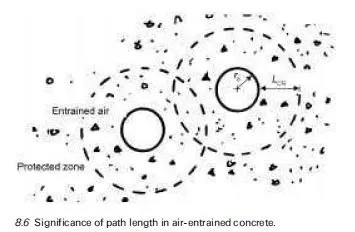Figure 9.4 shows the decrease in bending strength (expressed as a fraction of the 28-day strength, i.e. the initial strength after curing, at the start of service) for five types of PC based matrix frc, reinforced with either first or second generation alkali-resistant (AR) glass fibre, two types of natural fibre, sisal or coconut (coir), and polypropylene fibre, exposed outside in UK weather. The fibres in each case were intended to provide primary reinforcement. It can be seen that there are appreciable losses in strength with time, but that the magnitude of the loss is different for each frc, even within similar classes (i.e., glass or natural fibres). Thus it is difficult to make generalisations concerning the `durability’ of frc systems and each frc should be evaluated carefully. In general though, it appears from the available evidence that the durability of common primary frc proceeds polypropylene > 2nd generation AR glass >> 1st generation AR glass >> unprocessed natural fibres.
Although strength is the most frequently monitored property during ageing, other properties are often of more interest. As the action or efficiency of the fibres is degraded, by whatever mechanism, composite strength will decrease until the fibres confer no strength benefit, but the matrix strength will be retained since this tends to remain constant or increase with time. Thus strength in primary frc will only degrade until it is equal to the matrix strength, at which point it will remain more or less constant. In primary frc the matrix strength is typically around 20±50% of the original composite strength but in secondary frc, where the fibre content is close to or below the critical volume fraction and fibres are mainly intended to provide post-peak toughness (e.g., Fig. 9.2b), the original composite strength will be practically the same as the matrix strength. In such cases, it is more appropriate to monitor a toughness index (normally derived from the area under the stress-strain curve up to some specified strain) or strain-to-failure. Since both these properties of the matrix are negligible com- pared to that of the original composite, they will effectively degrade to zero. Such properties are, however, rather more difficult to measure than strength and often display very large scatter and hence strength remains the most popular metric. For example, processed natural fibre, i.e. cellulose-frc, is normally manufactured such that the fibre volume fraction is lower than or comparable to Vfcrit and it is thus not appropriate to monitor strength as a degradation metric; indeed, it increases by about half over five years outdoor exposure owing to continued hydration of the matrix and increased bond (hence increased lc and fibre efficiency factors). However, strain to failure is reduced from about 3% to that of the matrix (i.e., <0.1%) within this period (Akers and Studinka, 1989), indicating that the benefits of fibre reinforcement have been largely lost after such time even though strength has increased. Polymers other than polypropylene have also been used to reinforce concrete (Zheng and Feldman, 1995, Akers et al., 1989, Majumdar, 1992). Most either do not bond well to cement or are not stiff/strong enough to confer significant benefits and thus no weathering data exists. Akers and co-workers (1989) studied ageing of PVA-frc up to seven years. No strength loss was reported but it is not clear that the original fibre volume fraction was significantly above Vfcrit and thus this is not a conclusive result. Majumdar (1992) reported that strength was retained in PVA-frc after five years weathering but again the fibre volume fraction was very low, as evidenced by there being very little difference between the first-cracking and ultimate strength. Aramid-frc displayed no loss in properties after two years weathering (Walton and Majumdar, 1978) but more recent commentators express concern over the longer-term compatibility of aramid fibres with cement (Johnston, 2001, pp. 189±190). Polyester fibres are not suitable for concrete reinforcement as they degrade quickly in cement (Zheng and Feldman, 1995).
Carbon fibres have been generally assumed to be unaffected by the corrosive alkaline environment in cement composites and thus immune to the associated deterioration mechanisms (Majumdar, 1992, Ohama, 1989); recent investigators agree (Chung, 2000) although little if any long-term weathering data exists in the literature. Katz and Bentur (1995) and Katz (1996) have noted that the strength and toughness of carbon-frc reaches an optimum at ~30 days, after which a slight drop in properties may be observed owing to matrix densification; presumably these properties then stay constant. The magnitude of the effect was dependent on the matrix formulation, i.e. the proportion of silica-fume (see Section 9.2.3) added.
The durability of steel-frc has received comparatively little attention and tends to be approached in a different context in that it is compared with that of traditional reinforced concrete (RC), i.e. studies report the observation or other- wise of surface spalling and any compromise to structural integrity rather than decline in material properties. Bentur and Mindess (1990) and Johnston (2001) summarise steel-frc durability studies up to about the end of the century. Even under several months of severe accelerated corrosion conditions such as wetting/ drying cycles in hot salt solutions, Vf ˆ =2% steel-frc can retain at least 70% of its strength and 40% of its toughness (Kosa and Naaman, 1990). Granju and Balouch (2005) showed that fibre corrosion was not correlated with flexural strength or toughness loss after one year in a simulated marine environment even for pre-cracked specimens. Under normal conditions, no degradation other than superficial corrosion of surface fibres seems to have been reported. In a review, Hoff (1987) concluded that steel-frc will only degrade if it is cracked, even in marine environments.



